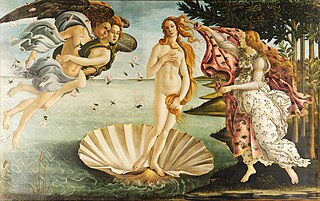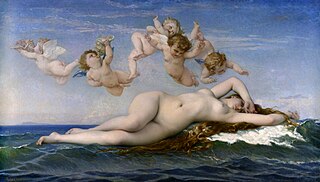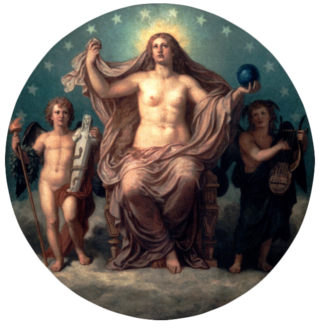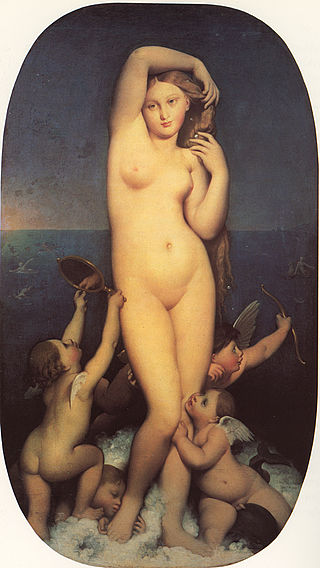The Birth of Venus is a 15th century painting by Sandro Botticelli.
The Birth of Venus may also refer to:

Aphrodite is an ancient Greek goddess associated with love, lust, beauty, pleasure, passion, procreation, and as her syncretized Roman goddess counterpart Venus, desire, sex, fertility, prosperity, and victory. Aphrodite's major symbols include seashells, myrtles, roses, doves, sparrows, and swans. The cult of Aphrodite was largely derived from that of the Phoenician goddess Astarte, a cognate of the East Semitic goddess Ishtar, whose cult was based on the Sumerian cult of Inanna. Aphrodite's main cult centers were Cythera, Cyprus, Corinth, and Athens. Her main festival was the Aphrodisia, which was celebrated annually in midsummer. In Laconia, Aphrodite was worshipped as a warrior goddess. She was also the patron goddess of prostitutes, an association which led early scholars to propose the concept of "sacred prostitution" in Greco-Roman culture, an idea which is now generally seen as erroneous.
Venus is the second planet from the Sun.

Venus is a Roman goddess, whose functions encompass love, beauty, desire, sex, fertility, prosperity, and victory. In Roman mythology, she was the ancestor of the Roman people through her son, Aeneas, who survived the fall of Troy and fled to Italy. Julius Caesar claimed her as his ancestor. Venus was central to many religious festivals, and was revered in Roman religion under numerous cult titles.

The Birth of Venus is a painting by the Italian artist Sandro Botticelli, probably executed in the mid 1480s. It depicts the goddess Venus arriving at the shore after her birth, when she had emerged from the sea fully-grown. The painting is in the Uffizi Gallery in Florence, Italy.
Vamp most commonly refers to:
Avvaiyar, Avviyar, or Auvaiyar is a Tamil title. It may refer to:

The Birth of Venus is one of the most famous paintings by 19th-century painter William-Adolphe Bouguereau. It depicts not the actual birth of Venus from the sea, but her transportation in a shell as a fully mature woman from the sea to Paphos in Cyprus. She is considered the epitome of the Classical Greek and Roman ideal of the female form and beauty, on par with Venus de Milo.
Venus and Adonis may refer to:

The Birth of Venus is a painting by the French artist Alexandre Cabanel. It was painted in 1863, and is now in the Musée d'Orsay in Paris. A second and smaller version from ca. 1864 is in Dahesh Museum of Art. A third version dates from 1875; it is in the Metropolitan Museum of Art in New York City.

Venus Anadyomene is one of the iconic representations of the goddess Venus (Aphrodite), made famous in a much-admired painting by Apelles, now lost, but described in Pliny's Natural History, with the anecdote that the great Apelles employed Campaspe, a mistress of Alexander the Great, for his model. According to Athenaeus, the idea of Aphrodite rising from the sea was inspired by the courtesan Phryne, who, during the time of the festivals of the Eleusinia and Poseidonia, often swam nude in the sea. A scallop shell, often found in Venus Anadyomenes, is a symbol of the female vulva.

Venus Anadyomene, is a c. 1520 oil painting by Titian, depicting Venus rising from the sea and wringing her hair, after her birth fully-grown. Venus, said to have been born from a shell, is identified by the shell at bottom left. It is smaller than usual in the birth of Venus scenes, such as Botticelli's, and is just intended to identify the subject rather than be a boat-like vessel for Venus, as in Sandro Botticelli's The Birth of Venus and other depictions.
Venus and Mars may refer to:

Fertility in art refers to any artistic work representing or portraying fertility, which usually refers to successful breeding among humans, although it may also mean successful agriculture and animal husbandry. It includes engravings, drawings, paintings, sculptures, figurines, portraits and even literary works. In Paleolithic art, fertility is usually associated with figurines with exaggerated parts of human anatomy.

Aphrodite Urania was an epithet of the Greek goddess Aphrodite, signifying a "heavenly" or "spiritual" aspect descended from the sky-god Ouranos to distinguish her from the more earthly epithet of Aphrodite Pandemos, "Aphrodite for all the people". The two were used to differentiate the more "celestial" love of body and soul from purely physical lust. Plato represented her as a daughter of the Greek god Uranus, conceived and born without a mother. Hesiod described this aspect as being born from the severed genitals of Uranus and emerged from the sea foam.
Venus and Cupid may refer to:
Anadyomene may refer to:
Erycina may refer to:

Venus Anadyomene is a painting by the French painter Jean-Auguste-Dominique Ingres. It is now held at the Musée Condé, Chantilly, France. It is a female nude of the Venus Anadyomene type, showing the goddess Venus rising from the sea.

The Birth of Venus is a 1907 painting by the French artist Henri Gervex. It is now in the Petit Palais, in Paris. It depicts the Greek goddess Venus (Aphrodite) washed up to shore after her birth, when she had emerged from the sea fully-grown.

Voyage of the Sable Venus and Other Poems is the debut collection of poetry by Robin Coste Lewis, published in 2015 by Alfred A. Knopf. The title poem, 79 pages long, is named for an image by British painter Thomas Stothard. The collection won the National Book Award for Poetry, the first debut collection to win the award since 1974.